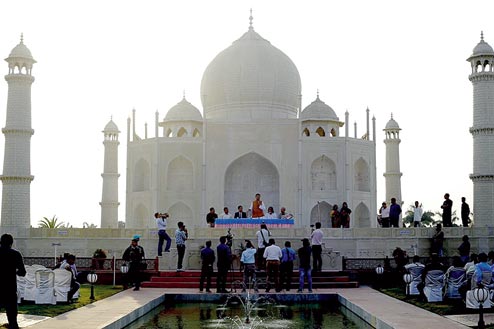Around the world in an hour, or even less. Visitors to Eco Park will be able to go one up on Phileas Fogg, Jules Verne’s protagonist who achieved the feat in 80 days. Sizeable replicas of the Seven Wonders of the World, under construction for the last year and half, have finally opened to public viewing.
The entry is through Gate 4 of Eco Park, right at the corner where Eco Park ends if one is coming from the Salt Lake side. Tickets cost Rs 30. The timings are same as at Eco Park — 12 noon to 7.30pm. Mondays are closed.
Building the seven wonders at Eco Park was chief minister Mamata Banerjee’s idea which public health engineering department engineers executed under the guidance of artiste and New Town resident Rupchand Kundu. “Bengalis love to travel. This will make the seven wonders accessible to them. Special packages are being offered to schools. We also plan to introduce light and sound shows here,” said Hidco chief Debashis Sen.
About five acres were demarcated from the parking lot at the north-eastern side of the park . Then came the matter of choosing the seven wonders from the ancient and the modern sets. “The seven wonders keep changing with shift in appraisal and new discoveries. But we had to freeze the list to go ahead,” said Kundu. Among those considered and discarded was the hanging gardens of Babylon, for which no physical evidence exists, and Machu Pichu, the Inca citadel in Peru. “It would have been difficult to create a mountain and show terrace farming. Neither would it have been aesthetically pleasing. Instead I chose the statues of Easter Island and the rock-cut architecture of Petra, Jordan.”

Taj Mahal
The most familiar and obvious presence is the Taj Mahal. It is about one-eighth of the original in Agra. The walls are made — not of marble — but of fibre glass. “Had marble been used entirely, it would have taken four to five years to finish construction as also have shot up the cost. But there is a bit of marble in the monument nonetheless if you look underfoot where marble slabs have been used. “Since there would be a lot of friction with visitors walking on the surface, we did not want to take any chances,” Kundu explained.
And if you are disappointed at finding the colour of the surface more off-white than milk white, he has an explanation for that too. “Marble usually is never completely white. There are swirls and veins along the surface, usually due to various mineral impurities, which give it a grey or yellow tone,” explaining why he went for a different shade. The steps leading up to the mausoleum are made of yellow sandstone, as in the vicinity of the original. A waterbody has been created in front of the edifice allowing the Taj to be clicked along with its reflection as is a popular practice with the original.
Kundu agrees that there could have been more finesse in the work had he got more time. “But then the Taj Mahal itself was worked upon for years after the main structure of the tomb was completed.”

Pyramid & Sphinx
A 40ft pyramid stands flanked by a smaller structure and the Sphinx. These may be dwarf-sized compared to the gigantic structures in the deserts of Egypt but there is scope to walk into the air-conditioned central pyramid. Inside, there is even a small sarcophagus inside. The lid has a figure of a king carved on it but do not try to prise it open in search of a mummy. There is none. The inside walls are lined with colourful paintings in the Egyptian style — torso shown frontally, and head and legs from the side.
The authorities would do well to remove the board bearing the “Please do not touch” stricture affixed to the chest of the Sphinx.
An artificial stream winds its way between the Pyramids and the Taj. “It stands for both the Yamuna and the Nile,” Kundu smiles.

Great Wall
While the actual wall in China spreads for thousands of kilometres along the mountain ridges, the Great Wall of New Town is about 100m long if the curves are straightened out. “I have taken only a fraction of the wall and represented it and the watch towers along its length. Since mountains can extend any which way, I could take that liberty.”
One could still walk up the wall and get an aerial view of the rest of the wonders as well as the Main Arterial Road right across the park’s boundary. “The yellow sandstone steps can take the weight of about 600 people.”

Petra
“Petra,” Kundu says, “shows how nomads in antiquity living in caves became inclined towards aesthetics and developed architectural sense.” While the main structure is modelled on El Deir or The Monastery in the ancient city of rock-cut architecture in Jordan, some pillars and rockfaces stand independent of the main structure. “Most of the extant structures have a prominent triangle pediment supported by columns over the porch, which is similar to the colonial architecture we see in Calcutta. So I chose the monastery which had a curious spherical formation atop its central circular cornice in the upper level.” The structure, about 50ft high, has a sandstone hue and can be entered into. The interior is cave-like and leads to another exit.

Colosseum
The Roman amphitheatre has been reduced to one-sixteenth of the original size which used to sit an audience of 65,000-plus in ancient Rome. The oval structure has a semblance of a gallery in a small section but it is just for show. Though an underground pit has been constructed to give the audience an idea of the hypogeum in which slaves and animals would be housed, there is scant chance of gladiatorial combats or bullfights happening in the arena. But the Hidco authorities have plans to start a light and sound programme. “There is provision to lay out 100 chairs or so and seat schoolchildren for a lesson in history,” says Kundu.

Moai statues
Just as the Moai of Easter Island stand along the coast and face inland, the replicas at Eco Park have been placed along the park’s eastern perimeter looking into the park. There are 32 figures, with heights varying from 15 to 19 ft. Placed in three uneven rows, they are great to click pictures with. One has been left lying on the ground in keeping with history as the Moai too had toppled by the 19th century.

Christ the Redeemer
The towering Art Deco statue of Jesus Christ, which became well-known during the 2014 Fifa World Cup and the 2016 Olympic Games in Brazil, is the most visible figure while passing by Eco Park. Since the original stands on the peak of the 2,300 ft Corcovado mountain overlooking Rio de Janeiro, a sense of elevation has been created by placing it on a raised base. “It is half in size of the original. Still we have taken care so it can withstand wind pressure or earthquake. There is as much of the structure underneath in concrete piling and iron structure as you see overground,” Kundu said.

Durga’s blessing
Kundu, a Government College of Art and Craft pass-out, is known for his theme-based Puja pandals. “It pains me so much to see my creations being dismantled or immersed every year. By Ma Durga’s grace and thanks to minister Firhad Hakim and Hidco chief Debashis Sen, here is a creation that will endure,” he smiles. The other bonus for the 57-year-old resident of Anahita, in Action Area 2, is getting to see his work regularly so close to home.
Pictures by Shubham Paul

Original 7
TAJ MAHAL: This symbol of love was built by Mughal emperor Shah Jahan in memory of his wife Mumtaz Mahal. It was built in 1632 on the banks of the Yamuna River in Agra.
Christ the Redeemer: The statue was installed in Rio de Janeiro, Brazil, in 1931. It is 98-ft tall and stands on a 26-ft pedestal atop Corcovado Mountain. The outstretched arms of Jesus signify peace. A chapel has come up under the statue now that holds baptisms and weddings.
Moai: Moai are monolithic human figures carved out by the natives of the Chilean Polynesian island named Easter Island. Created between 1250 and 1500, almost all the figures have overly large heads, said to represent deceased ancestors. Hundreds of these statues are lined along the coast of the islands. The tallest Moai is 33-ft high and the heaviest one weighs 86 tonnes. So how the ancient people transported them around is a mystery.
Great Wall of China: The Great Wall of China traverses 21,196km in the east-west direction protecting the historical border of the land from foreign invasion. Several kings made parts of this wall, some as early as in the 7th century BC, which were then joined. The most famous portions of the wall were built under Qin Shi Huang, the first Emperor of China.
Colosseum: Rome’s Colosseum is the largest amphitheatre ever built. Construction had started in 72 AD and could hold up to 80,000 spectators. It would be used for gladiator fights, executions, drama etc. The monument has got ruined partially due to earthquakes and stone-robbers but is still considered one of the greatest architectural feats ever.
Petra: Petra is an ancient city in Jordan, full of rock-cut architecture. There are several mausoleums carved out of sandstone rock and Al Khazneh, the royal treasury, is the most famous. Legend has it that it served as the Egyptian pharaoh’s treasury during the time of Moses. Petra is also known as the Rose City due to the colour of the stones it is carved out of.
Pyramid of Giza: Built over a period of 20 years, the pyramid was completed in circa 2,560 BC. It was commissioned by the Pharaoh Khufu and stands at a height of 481ft. It is the oldest and largest of the pyramids in the Giza pyramid complex of Egypt. There are three small pyramids surrounding the main one, each dedicated to the pharaoh’s three wives.
Which of the Seven Wonders of New Town do you like best?
Write to The Telegraph Salt Lake, 6 Prafulla Sarkar Street,
Calcutta 700001 or email to saltlake@abpmail.com










